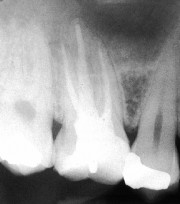1. Amalgam free fillings
Amalgam is used in dentistry for almost 150 years. It has several disadvantages. It has a grey colour and it becomes darker through the years. It discolours the tooth because it shines through the enamel. It also contains mercury, which dissolves under the influence of other metals or acids in the mouth. Consequently, it comes slowly in our body which is not really healthy. Therefore, since 10 years we do not use amalgam anymore in our clinic.
We suggest you to replace all amalgam fillings older than 8 years (average duration of a filling) for new materials such as:
Composites: They are used to replace small amalgam fillings and also when you have small amount of decay. The colour of these fillings is the same as the colour of your own teeth which makes them aesthetically superior then amalgam.
Treatment time is usually half an hour per filling.
Life span is between 6 to 8 years depending on the use and on your oral hygiene.
Inlays/Onlays of porcelain: We can make porcelain fillings when your old fillings are too big to make new ones but still too small to make a crown. This material is much stronger than a composite filling. It is also very aesthetic.
Treatment time is longer than for a normal filling. We have to make an impression for the laboratory. Therefore, we need two sessions of 45 minutes for each Inlay/Onlays. Life span is approximately 15 years depending on your oral hygiene.
Back
2. Root canal treatment (endodontic)

This treatment is done when we touch a nerve at a crown preparation,
when we have to remove deep caries or if the root is infected.
Treatment time takes normally several sessions depending on the progress of the infection and the sensitivity of the tooth.
Back
3. Hygiene / Periodontology / Check-ups
To have your teeth cleaned by the hygienist belongs to the half yearly maintenance of your mouth.
If the gums are slightly bleeding, it is often due to minor infection
(= Gingivitis). When you have it treated adequately, the Gingivitis can
be totally cured. The problem arises when the infection becomes chronic
and undermines the essential structures of the tooth anchorage (=
Periondotitis). As a result of Periondotitis you lose bone. To prevent
you from loosing teeth we need several treatments to stop the
infection. The loss of bone is often irreversible. In this case we need
several checkups per year.
Remember:
- Brush your teeth after each meal
- Daily use of dental floss
- Use mouth water containing chlorhexidine
- Visit your dentist regularly (half yearly control)
Back
4. Denture

A denture is to replace your lost teeth.
Full denture: It is made from acrylic and used when there are no teeth left in the mouth. We need normally 4 to 5 sessions for a full denture unless you choose an immediate denture. This is a denture that is placed in the same session as the teeth are taken out.
Frame denture: If you still have enough teeth in the jaw, we can make a denture with a metal frame. This metal frame is grasped around the still existing teeth. In that way, the denture is anchored to the teeth. Unfortunately it is possible that you lose teeth at an earlier stage because of the frame structure. Treatment time is approximately 5 session of half an hour.
Back
5. Fixed bridge or crowns
Bridge: The difference with a removable denture is that this is a fixed solution. We trim the adjacent teeth and place a bridge. It can be made of metal-porcelain or entirely porcelain. We can also make the bridges on top of implants (for further information click on implants).
Treatment time is approximately 4 sessions for a bridge.
Duration is approximately 15 years depending on your oral hygiene.
Crown: For a crown we only have to trim one tooth on which we cement a porcelain or metal-porcelain crown.
Treatment time is 3 sessions.
Life span is approximately 15 years depending on your oral hygiene.
Back
6. Sensitive teeth

Are Your Teeth Sensitive?
Is a taste of ice cream or a sip of hot coffee sometimes a painful experience for you? Does brushing or flossing make you wince occasionally? If so, you may have a common problem called "sensitive teeth."
Cavities and fractured teeth can cause sensitive teeth. But if your dentist has ruled these problems out, then worn tooth enamel, a cracked tooth or an exposed tooth root may be the cause.
A layer of enamel, the strongest substance in the body, protects the crowns of healthy teeth. A layer called cementum protects the tooth root under the gum line. Underneath the enamel and the cementum is dentin, a part of the tooth that is less dense than enamel or cementum.
The dentin contains microscopic tubules (small hollow tubes or canals). When the dentin loses its protective covering, the tubules allow heat and cold or acidic or sticky foods to stimulate the nerves and cells inside the tooth. This causes hypersensitivity and occasional discomfort. Fortunately, the irritation does not cause permanent damage to the pulp. Dentin may be exposed when gums recede. The result can be hypersensitivity near the gum line.
Proper oral hygiene is the key to preventing gums from receding and causing sensitive-tooth pain. If you brush your teeth incorrectly or even over-brush, gum problems can result. Ask Dr. Koole if you have any questions about your daily oral hygiene routine.
Treating Sensitive Teeth
Sensitive teeth can be treated. Your dentist may suggest that you try a desensitizing toothpaste, which contains compounds that help block transmission of sensation from the tooth surface to the nerve. Desensitizing toothpaste usually requires several applications before the sensitivity is reduced. If the desensitizing toothpaste does not ease your discomfort, your dentist may suggest in-office techniques. A fluoride gel , which strengthens tooth enamel and reduces the transmission of sensations, may be applied to the sensitive areas of the teeth.
Back